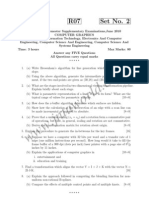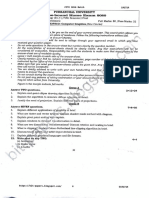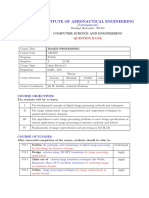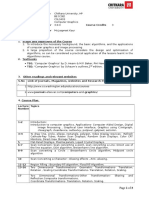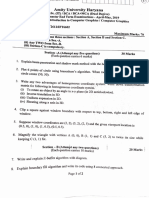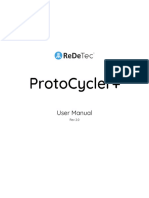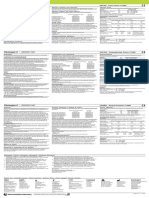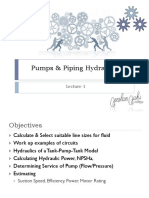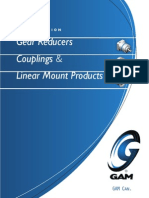o:}qtcs|:}o4052205
APJ ABDUL KALAM TECHNOLOGICAL UNIVERSI
B.Tech Degree S6 (&S) / 54 Gb $,S) Examination May 2024 (201
Course Code: CST304
Course Name: COMPUTER GRAPHICS AND IMAGE PROCESSING
Max. Marks: 100 Duration:3 Hours
PART A
Answer all questions, eoch carries 3 marks.
I Write any three applications of computer graphics. (3)
2 Find the points in the line from (5, 6) to (8, 12) using the DDA line drawing (3)
algorithm.
Given a triangle with vertices at coordinates (10,20), (10,10), (20,10). Find the (3)
coordinates of vertices after Scaling with parameters Sx:2, Sy:l.5, with respect
to the origin.
4 List the steps for general pivot point rotation. (3)
5r Differentiate parallel and perspective projections. (3)
6 Perform window to viewport transformation for the point (20,15). Assume that (3)
(Xwmin , Yr",nin) is (0, 0); (X*.* , Y"r.o) is (100, 100); (X"tin , Yvmin) is (5, 5);
' (X"ro, Y"ro) is (20' 20).
7 List any three applications of digital image processing. (3)
8 The spatial resolution of an image is given by 128 X 128. What is the storage (3)
requirement if it is represented by 256 gray levels?
9 Explain the terms (i) Smoothing (ii) Sharpening (3)
l0 Explain any two thresholding techniques used in image segmentation. (3)
.Page 1of 3
E
� (x|cstilt4os220s
PART B
Answer onclull qudionttueoch module, each carries 11 marks.
Module I
I I a) Explain any seven applications of omputer graphics. (7)
b) Write Bresenham's circle drawing algorithm. Find the points in a circle octant in (7)
the first quadrant with the centre point coordinates (0, 0) and radius as 8.
OR
12 a) Explain the working of the raster scan system with suitable figures. (7)
b) Explain Bresenham's Line drawing algorithm with the help of an example. (7)
Module II
13 a) Explain scan line polygon fill algorithm. What problem does the algorithm (7)
encounter when a scan line passes through a vertex?
.
b) Perform the following transformatiort on a triangle with vertices A(0, 0), B(1, 0) (7)
and C(1, l). Find out the new coordinates and draw the result of each
transformation.
i) Rotate the triangle by 90 degree anticlockwise direction.
iD ii) Reflection about x axis.
OR
14 a) Explain Boundary fill algorithm to fill the interior of any specified area. (7)
*
Differentiate Boundary fill and flood filtdgorithms.
b) Prove that the multiplication of transformation matrices for each of the following (7)
sequence of operations is commutative :
i) AnV two successive translations.
iD Any two successive scaling operations.
lr
Page 2of3
� 0300csT3040/52205
Module III
l5 a) Explain cohen sutherland line clippjng algorithm with an example. (7)
b) Explain the Scan line method for visible surface detection. (7)
OR
16 a) Explain Depth buffer algorithm for visible surface detection. Write any two (7)
- disadvantages of the Depth buffer algorithm.
b) Describe perspective projection. Derive transformation matrix for perspective (7)
projection.
;t
Module IV
17 a) With the help of a block diagram, describe in detail the fundamental steps in image (7)
processing.
b) What is image convolution? Explain various steps involved in image convolution (7)
with the help of an example.
OR
l8 a) Explain the basic relationships between pixels? e)
b) Explain the concept of image sampling and quantization. (7)
I Module v
19. a) What is image segmentation? Explain edge and region based segmentation (7)
technique.
b) E*plain histogram equalization method of image epfancement. (7)'
OR
20 a) Explain any two gray level transformation functions. (7)
b) Describe hory an image is segmented using split and merge technique in (7)
. association with the region adjacency graph.
***!F
Page 3of3








